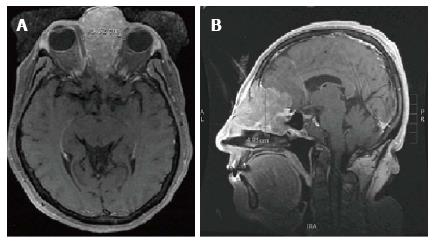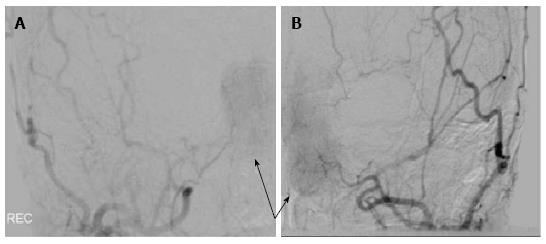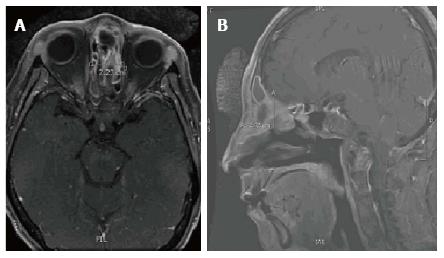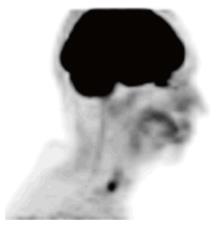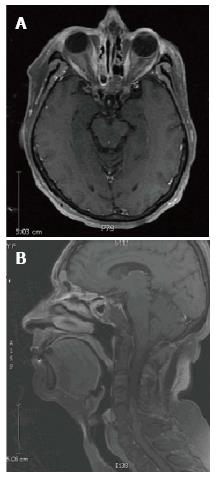Copyright
©The Author(s) 2015.
World J Clin Cases. Feb 16, 2015; 3(2): 191-195
Published online Feb 16, 2015. doi: 10.12998/wjcc.v3.i2.191
Published online Feb 16, 2015. doi: 10.12998/wjcc.v3.i2.191
Figure 1 T1 magnetic resonance imaging of sinonasal undifferentiated carcinoma neoplasm prior to treatment.
A: Axial T1 magnetic resonance imaging (MRI) and B: Sagittal T1 MRI show an avidly enhancing mass centered in the left ethmoid air cells with extension into the left frontal sinus with adjacent retained fluid and maxillary sinus with erosion of the medial orbital walls bilaterally, left greater than right. The majority of the ethmoid air cells are replaced by the neoplasm. Extension through the cribriform plate is noted with involvement of the left olfactory lobe, predominantly along the gyrus rectus. There is extensive surrounding edema in the left frontal lobe, extending back to the frontal horn of the left lateral ventricle.
Figure 2 Right and left external carotid artery angiography injections.
A: Right and B: Left external carotid angiographic injections demonstrate the tumor blush (arrows) at the first chemo treatment.
Figure 3 T1 Magnetic resonance imaging after completing fourth dose of chemotherapy.
A: Axial T1 magnetic resonance imaging (MRI) and B: Sagittal T1 MRI show the mass had decreased in size as compared to the prior to treatment MRI. The mediolateral dimension is 2.23 cm which is decreased in size from the prior examination at which time it measured 3.32 cm. The AP appears to have decreased in size to 2.42 cm as compared to 4.93 cm on the prior MRI. There appears to be residual enhancing tissue in the right posterior ethmoid. The intracranial enhancement and edema within the inferior left frontal lobe is significantly decreased.
Figure 4 Positron emission tomography performed at four months post-treatment.
The Positron emission tomography shows no definite or abnormal fluorodeoxyglucose (FDG) activity to suggest the presence of metabolically active tumor with special attention to the ethmoidal region adjacent to the cribriform plate. Linear FDG activity in the distal esophagus likely represents esophagitis.
Figure 5 T1 magnetic resonance imaging 30 mo post-treatment.
A: Axial T1 magnetic resonance imaging (MRI) and B: Sagittal T1 MRI show no evidence of recurrent disease. There is a decrease of the previously noted inflammatory changes in the sinuses. There is retained fluid in the bilateral frontal and left sphenoid sinuses, without bony destruction or expansion.
- Citation: Noticewala SS, Mell LK, Olson SE, Read W. Survival in unresectable sinonasal undifferentiated carcinoma treated with concurrent intra-arterial cisplatin and radiation. World J Clin Cases 2015; 3(2): 191-195
- URL: https://www.wjgnet.com/2307-8960/full/v3/i2/191.htm
- DOI: https://dx.doi.org/10.12998/wjcc.v3.i2.191













